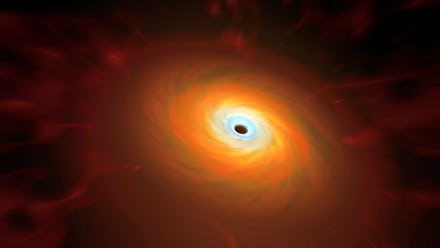Giant black holes are devouring smaller ones like 'Pac-Man'

When it comes to bizarre objects in space, black holes really do take the cake. They can spaghettify you if you get too close to them. They can slingshot stars all the way out of the Milky Way. Now, it seems, they may actually get bigger by "eating" other black holes. Talk about a never-ending appetite.
According to research published in the journal Physical Review Letters, astrophysicist Richard O'Shaughnessy believes black holes begin merging with other, smaller holes, exhibiting "Pac-Man-like behavior," which means massive black holes have ways to get even bigger.
Simulations reveal that this could be happening in the zone directly outside of a supermassive black hole's gravitational reach. Stars, dust, gas, and additional black holes are drawn to this "accretion disk" — the area around a black hole where matter gets caught. The larger black hole begins to "gobble up" the celestial bodies around it, resulting in a larger black hole. This is where the fun Pac-Man comparison stems from. The video game, if you're unfamiliar with it, features the diminutive yellow character traveling around a maze gobbling up "power pills" as colorful ghosts chase him in a bid to take him out. Pac-Man can eat larger power pills to grow larger and eat the ghosts instead.
The black holes' behavior could also be likened to the video game Katamari Damacy, where players are tasked with collecting objects while rolling them up into a gigantic ball that gets bigger over time. The more objects players collect, the bigger the ball will be. It can grow to the size of planets later on in the game, and it's a good representation of how black holes come to get so ridiculously large using this latest simulation.
The collision and merging of these black holes makes for some impressively large events out in space, and could very well explain some of the stranger behaviors they've exhibited and scientists have captured.
"This could be a unique way of probing the physics around these supermassive black holes," said O'Shaughnessy of these findings in a statement, who's located at the Rochester Institute of Technology in New York. "It offers unique insight into how the centers of galaxies grow, which is of course essential to understanding how galaxies as a whole grow, which explains most of the structure in the universe."
So far, researchers around the world have identified at least 10 black hole mergers, thanks to the Virgo observatory as well as the Advanced Laser Interferometer Gravitational-Wave Observatory (LIGO). The combination of both tools were able to help detect a neutron star collision for the first time, as well as the biggest black hole merger ever recorded.
Now that scientists know a bit more about how black holes behave when "consuming" each other and merging, the next step for scientists is to find more gravitational waves that show off the same signature as larger, spinning black holes. One of the mergers scientists observed was actually beyond the realm of their understanding, thanks to its bizarre characteristics. Researchers will be looking to make sense of this one in the future as well.